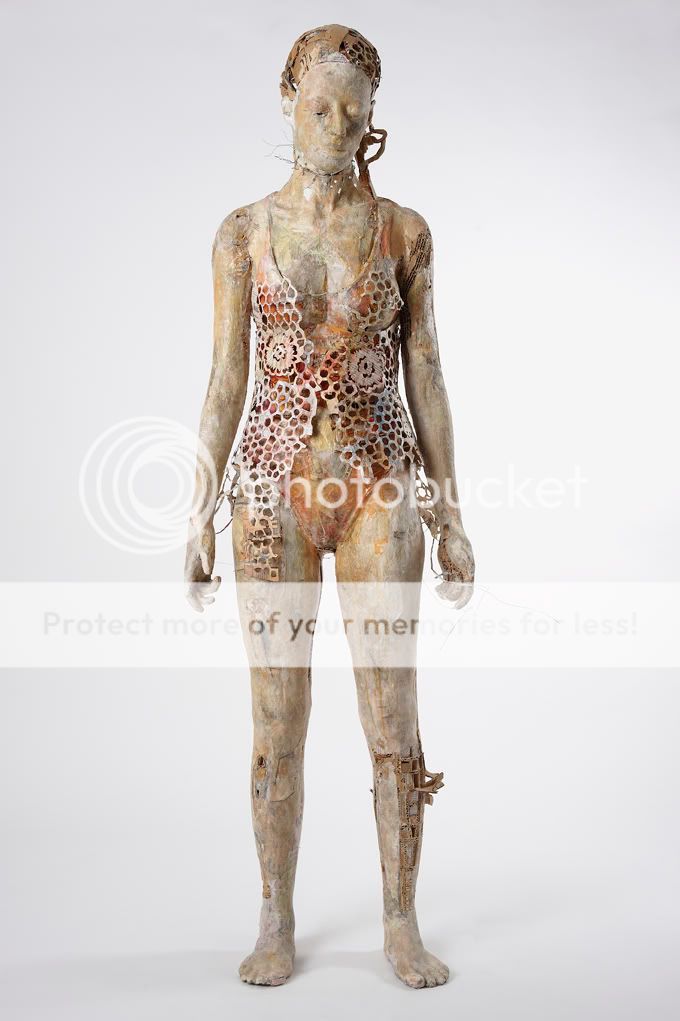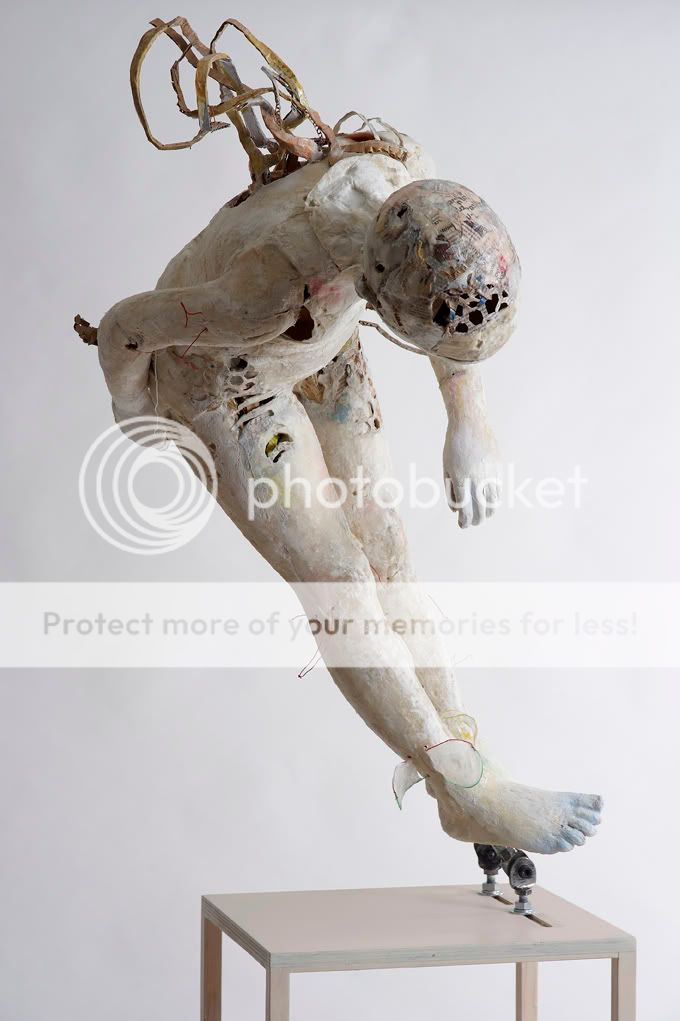 Vally Nomidou's paper sculptures first caught my attention because of their resemblance to Gehard Demetz's wooden children. But as much as I am captured by Demetz's little ghosts, there's something about Nomidou's creations that seem more raw, more real, though they are, in fact, made of something more processed . Both artists have chosen, with some purpose, we must assume, a subgroup of humanity as their subject matter. Demetz has chosen children, a classification he could once claim, while Nomidou has chosen women (of various ages), a classification to which she will always lay claim. There is mediation between vulnerability and strength which is echoed in material form. Their materials are the same, and yet they are not. Both are hewn from plants and trees--alive things made un-alive--and reconstituted as strange, Pinocchio-like creatures who aren't alive, but are, or would like nothing more than to be so.
Vally Nomidou's paper sculptures first caught my attention because of their resemblance to Gehard Demetz's wooden children. But as much as I am captured by Demetz's little ghosts, there's something about Nomidou's creations that seem more raw, more real, though they are, in fact, made of something more processed . Both artists have chosen, with some purpose, we must assume, a subgroup of humanity as their subject matter. Demetz has chosen children, a classification he could once claim, while Nomidou has chosen women (of various ages), a classification to which she will always lay claim. There is mediation between vulnerability and strength which is echoed in material form. Their materials are the same, and yet they are not. Both are hewn from plants and trees--alive things made un-alive--and reconstituted as strange, Pinocchio-like creatures who aren't alive, but are, or would like nothing more than to be so.  I read a wonderful article on Nomidou's Let it Bleed exhibition, written by Dr. Lina Tsikouta-Deimezi. She discusses the roles of Existentialism, Phenomenology, and Freudian psychoanalysis in Nomidou's work, quoting Sartre: "Existence precedes essence." I like the trajectory this gives the art. It is as though the form has come to being, materialized as the precursor of some phantom will. Its existence is a process begun in the form, which is partially-but-not-completely dormant. They're not sentient in the way that Demetz's sculptures are. These are more like the crumbling white skins left behind by serpents than the serpents themselves.
I read a wonderful article on Nomidou's Let it Bleed exhibition, written by Dr. Lina Tsikouta-Deimezi. She discusses the roles of Existentialism, Phenomenology, and Freudian psychoanalysis in Nomidou's work, quoting Sartre: "Existence precedes essence." I like the trajectory this gives the art. It is as though the form has come to being, materialized as the precursor of some phantom will. Its existence is a process begun in the form, which is partially-but-not-completely dormant. They're not sentient in the way that Demetz's sculptures are. These are more like the crumbling white skins left behind by serpents than the serpents themselves. 
 I think it is worth noting that, unlike Demetz's children, Vally Nomidou's women don't ever really seem to engage the viewer. Some of them lift their heads and look forward, but never with the same self-possession as their wooden counterparts. The majority cast their closed eyes downward, tired, sad, dejected, or ashamed, perhaps.
I think it is worth noting that, unlike Demetz's children, Vally Nomidou's women don't ever really seem to engage the viewer. Some of them lift their heads and look forward, but never with the same self-possession as their wooden counterparts. The majority cast their closed eyes downward, tired, sad, dejected, or ashamed, perhaps. 
In some of Nomidou's women and girls, holes bored into the skull or slashes made in the torso show a stratification of newsprint and cardboard which are really all different versions of the same thing. There is no true inner framework, no difference between core and crust. In some places paper innards spill out like film from a much-loved cassette, while in others we see wire and seams, as though bits of flesh have only been closed together over that percolating consciousness.
 When I was writing my undergraduate thesis, I found Natalie Kosoi's 2005 article on the relationship of Rothko's paintings to Sartre's and Heidegger's philosophies very helpful because it posited that art as a medium reveals an essential human anxiety about the inevitability of death.For Heidegger, it is the primordial condition of “nothingness” which constitutes all that is anything. Existence is realized only in relation to the nothingness of which a thing is born, that which surrounds it, and that which it must become upon death/non-existence. Anything that exists does so like a tiny light turned on temporarily in a dark room; there is a force, unseen and unseeable, which turns it on, a period during which it burns, and a force that turns it off, returning the room to darkness. But without the darkness, the light would be meaningless; sudden light in a room already illuminated goes unnoticed. The human being is thus constituted by his eventual return to non-being (death). In Nomidou's work, I find this with the interplay between sculptures that are inhabited, and sculptures that are not. Most especially, in sculptures which are becoming inhabited. It is directional, and almost a inversion of Heidegger's theory of non-being.
When I was writing my undergraduate thesis, I found Natalie Kosoi's 2005 article on the relationship of Rothko's paintings to Sartre's and Heidegger's philosophies very helpful because it posited that art as a medium reveals an essential human anxiety about the inevitability of death.For Heidegger, it is the primordial condition of “nothingness” which constitutes all that is anything. Existence is realized only in relation to the nothingness of which a thing is born, that which surrounds it, and that which it must become upon death/non-existence. Anything that exists does so like a tiny light turned on temporarily in a dark room; there is a force, unseen and unseeable, which turns it on, a period during which it burns, and a force that turns it off, returning the room to darkness. But without the darkness, the light would be meaningless; sudden light in a room already illuminated goes unnoticed. The human being is thus constituted by his eventual return to non-being (death). In Nomidou's work, I find this with the interplay between sculptures that are inhabited, and sculptures that are not. Most especially, in sculptures which are becoming inhabited. It is directional, and almost a inversion of Heidegger's theory of non-being. 

No comments:
Post a Comment